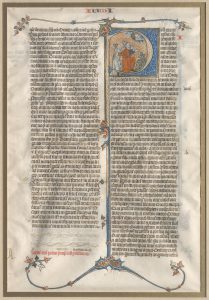A Leaf in Dallas from “Otto Ege Manuscript 14” (Lectern Bible)
January 11, 2022 in Manuscript Studies

Virginia Lazenby O’Hara Fine Books Division, Dallas Public Library, Framed Leaf from Otto Ege Manuscript 14, ‘Recto’, top right: Initial P for ‘Post’ of Judges 1:1.
An Old Testament Leaf
from ‘Otto Ege Manuscript 14’
with the end of Joshua
and the beginning of Judges
in the
Virginia Lazenby O’Hara
Fine Books Division
of the Dallas Public Library
City of Dallas, Texas
Large-format Latin Vulgate Lectern Bible
(“the Bible of ‘Mirmelus Arnandi’ “)
made in France, late 13th- or early 14th century
Single Leaf mounted behind glass within a matted frame
Double columns of 50 lines
Visible side of the leaf (‘Recto’):
Joshua 24:18 ([igitur Dominus quia /] ipse Dominus – 24:38 (end)
and Judges 1:1 –15 (ending the verse with inriguum inferius [/ Filii autem . . . beginning 1:16])
With rubricated and polchrome elements, running titles, concluding-and-opening titles,
decorated and historiated initials, border ornament,
embellished pen-line line-fillers, and added lection marks
[Posted on 10 January 2022, with updates]
Continuing the series of posts for our blog on Manuscript Studies, Mildred Budny describes another leaf from ‘Otto Ege Manuscript 14’, a large-format copy on vellum of the full Latin Bible in the Vulgate Version.

Virginia Lazenby O’Hara Fine Books Division, Dallas Public Library, Framed Leaf from Otto Ege Manuscript 14, ‘Recto’ of Leaf.
With thanks to Molly Tepera of the Dallas Public Library of the City of Dallas, Texas, I can report details of a single, framed Leaf in its Virginia Lazenby O’Hara Fine Books Division from one of the celebrated manuscripts owned by Otto F. Ege (1888–1951). Now fragmented, the book has become known as ‘Otto Ege Manuscript 14’. The Dallas Leaf can be cited thus:
Framed Leaf from Otto Ege Manuscript 14
Virginia Lazenby O’Hara Fine Books Division
Dallas Public Library.
From the Old Testament portion of the manuscript, the Leaf carries the end of the Book of Joshua and the beginning of the Book of Judges. A principal highlight is the framed illustration within its opening initial for Judges.
Many features of the Leaf correspond closely with other leaves from the same book. They include its representation of the Vulgate Version with some textual variants, its layout in double columns of 50 lines on the page, its Gothic script for the main text and for corrections inserted in the margins, its expansive decoration with foliate and zoomorphic ornament which often extends into the margins, its illustrated (or ‘historiated’) initial with a scene relating to the text, and its supplied lection marks in the margins (for reading aloud). Some features with the Leaf are unusual in the manuscript or specific to this Leaf, as with the full-line stretches of pen-line line-fillers on the one hand, and the present frame for the object on the other.
Some discoveries for the manuscript have been reported in our blog.
- A New Leaf from ‘Otto Ege Manuscript 14’
- More Discoveries for ‘Otto Ege Manuscript 14’
- A Leaf from ‘Otto Ege Manuscript 19’ and Ege’s Workshop Practices
- Updates for Some ‘Otto Ege Manuscripts’ (Ege MSS 8, 14, 41, and 61)
- Some Leaves in Set 1 of ‘Ege’s FOL Portfolio’ (Ege MSS 8, 14, 19, and 41)
See also The Illustrated Handlist (Number 4).
As more research and discoveries continue apace for Otto Ege’s dispersed manuscripts by various scholars, curators, owners, vendors, and others, it might suffice, for this report, to mention the publication in print recently of an account by Peter Kidd of a detached New Testament leaf from this manuscript in the McCarthy Collection, along with a list of known leaves having historiated initials.
Peter Kidd, The McCarthy Collection, Volume III: French Miniatures (London: Ad Ilissum, 2021), number 60, “Historiated initial on a leaf from the Bible of Mirmelus Arnandi” (pp. 199–202).
That leaf carries the end of one of the Pauline Epistles and the beginning of the next: the Epistle to the Colossians and the beginning of that to the First Epistle to the Thessalonians, with a historiated initial on its recto. The initial shows Saint Paul, traditionally regarded as the author, sitting and holding both sword and book.
Peter Kidd’s title for the manuscript derives from the purported name of a medieval owner, “Mirmelus Arnandi” (a lawyer and judge), recorded within its pages. The attribution is, however, subject to revision, because modern views of that name may represent a misreading. See, for example:
- MS 223: SEMI-QUADRATA BIBLE
- The last leaf of the Psalms, from a very large Bible, in Latin [France (Paris), c.1300]
- No. 6, From the so-called Bible of “Mirmelus Arnandi”
- McCarthy Catalogue Vol. III (French Illuminations), note for Catalogue no. 60, with Kidd’s update for its entry.

Cornerstone of the Dallas Public Library’s original Carnegie Library in downtown Dallas, Texas. Photograph from Wikimedia via Creative Commons.
The continuing flow of publications, in print or online, of yet more leaves from Otto Ege’s dispersed manuscripts, including his ‘Manuscript 14’, bring their features into view. Images reproduced from the individual remnants, while always useful, vary greatly in degree, quality, and size of reproduction. Sometimes those publications include recognition — by images, descriptions, or mentions alone — of the frames, mats, or other accompaniments for the leaves. More often they do not.
In the case of the Leaf in the Dallas Public Library, the images supplied by Molly Tepera fortunately show and share some accompanying material evidence.
Thus, this Report might set the Leaf both into the context of the manuscript, as the dispersed book becomes better known from its remnants, and into the context of Otto Ege’s workshop practices in preparing individual leaves (or occasionally bifolia, in a pair of connected leaves) for distribution and sale. The Report builds upon, and advances, my earlier reports about parts of Ege Manuscript 14 itself (see above) and my cumulative observations recorded for
